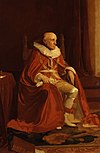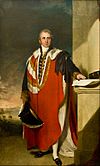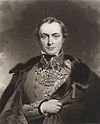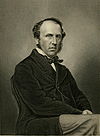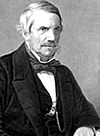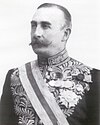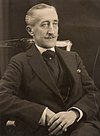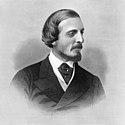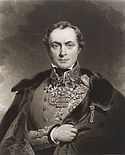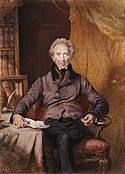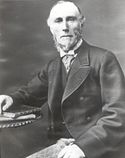Generální guvernér Indie

Funkce generálního guvernéra Indie (Governor–General of India) byla zřízena krátce po sedmileté válce, v níž Británie významně rozšířila svůj vliv v jihovýchodní Asii na úkor Francie. Warren Hastings, který byl od roku 1772 guvernérem v Bengálsku, byl stoupencem názoru, že britské kolonie v Indii by měly být řízeny centrálně, získal pod kontrolu Madras a Bombaj a v roce 1773 byl jmenován generálním guvernérem Bengálska, respektive indickým generálním guvernérem. Formálně se název Governor-General of India užíval až od roku 1833 na základě zákona o Indii. Generální guvernér byl podřízen Východoindické společnosti, která jej jmenovala. Východoindická společnost byla již od konce války s USA postavena pod státní dozor a funkce prezidenta kontrolního úřadu Východoindické společnosti (President of the Board of Control) patřila k důležitým ministerským postům. Personální obsazení funkce indického generálního guvernéra bylo tak od konce 18. století do značné míry politickou záležitosti britské vlády.
Po indickém povstání (1857) byla Východoindická společnost zrušena a správa Indie přešla přímo pod britskou korunu. Na základě nové indické ústavy se dosavadní generální guvernér Charles Canning stal 1. listopadu 1858 prvním indickým místokrálem. Místokrál byl podřízen nově zřízenému ministerstvu pro Indii. Po druhé světové válce byla Indie rozdělena (Zákon o nezávislosti Indie) a v srpnu 1947 vznikly nezávislé státy Indie a Pákistán. Louis Mountbatten, dosavadní místokrál, byl nadále jen generálním guvernérem Indické unie. Funkce generálního guvernéra Indie zanikla po vyhlášení Indické republiky (1950).
Sídlem indických generálních guvernérů byla od 18. století Kalkata, kde nechal lord Wellesley, bratr maršála Wellingtona, v letech 1801–1803 postavit místodržitelský palác Government House. Na popud místokrále Hardinga se v roce 1911 hlavním městem Indie stalo Dillí. Zde byl v letech 1912–1929 vystavěn nový místokrálovský palác, nyní rezidence indických prezidentů (Raštrapati Bavan), jehož projektantem byl architekt Edwin Luytens, zeť indického místokrále lorda Lyttona.
Seznam generálních guvernérů
Související články
- Raštrapati Bavan
Literatura
- STRNAD, Jaroslav, a kol. Dějiny Indie. Praha: Lidové Noviny, 2003. (Dějiny států). ISBN 80-7106-493-9.
- Ottův slovník naučný, díl 12.; Praha, 1897 (reprint 1998), s. 574–575, 594–598 ISBN 80-7185-157-4
- WANNER, Michal. Zrození impéria. Východoindická společnost a britský stát (1600-1773). Praha: Dokořán, 2003. 338 s. ISBN 80-86569-21-7.
Média použitá na této stránce
given to the National Portrait Gallery, London in 1890.
This set of images was gathered by User:Dcoetzee from the National Portrait Gallery, London website using a special tool. All images in this batch have been confirmed as author died before 1939 according to the official death date listed by the NPG.In 1816 Baron William Pitt Amherst (1773–1857) led a diplomatic mission to China to negotiate better trading terms for the British East India Company. This grand portrait by Thomas Lawrence, the leading English portraitist of the day, shows Amherst standing before the Canton harbor and the trading warehouses of Britain, the Netherlands, and the United States. The book near his hand is the 1817 publication of the journal of his diplomatic journey.
Amherst’s mission was a failure. He signaled that he would refuse to kowtow (kòu tóu)—the traditional act of reverence before the Chinese emperor, which involved kneeling and bowing low to the ground—unless the Chinese officials would show similar deference to a portrait of the British king. Affronted, Emperor Jiaqing sent Amherst and his embassy home without meeting with them.
Back at home Amherst was admired for his actions, which were seen as upholding British honor. This portrait, in fact, was commissioned to hang in the British East India Company’s office in Canton. The full-length format, imposing column, and Amherst’s determined expression and official ambassadorial robes all express solemn ceremony, resolve, and dignity.
James Andrew Broun-Ramsay, 1st Marquess of Dalhousie KT, PC (22 April 1812 – 19 December 1860)
Governor of Queensland, Lord Chelmsford (1906-1909) posing in the Windsor uniform
A view looking eastwards along Esplanade Row, with Richard Westmacott's statue of Sir William Cavendish-Bentinck, Governor-General of India from 1833-1835, in the foreground and the western entrance to Government House beyond. Government House, designed by Captain Charles Wyatt and built between 1799-1802, was the residence for the British Governors-General till 1911. Photographer: Samuel Bourne
George Robinson, 1st Marquess of Ripon, Viceroy of India 1880-1884
The Marquis of Ripon, Viceroy of India. Illustration for The Illustrated London News, 7 August 1880.
Freeman Freeman-Thomas, governor general of Canada
Sir George Barlow, 1st Bt, by unknown artist, given to the National Portrait Gallery, London in 1974. See source website for additional information. This set of images was gathered by User:Dcoetzee from the National Portrait Gallery, London website using a special tool. All images in this batch have an unknown author, but there is strong evidence it was first published before 1923 (based mainly on the NPG's estimated date of the work).
Charles Theophilus Metcalfe, 1st Baron Metcalfe, by George Chinnery (died 1852). See source website for additional information.
This set of images was gathered by User:Dcoetzee from the National Portrait Gallery, London website using a special tool. All images in this batch have been confirmed as author died before 1939 according to the official death date listed by the NPG.Richard Colley Wellesley, Marquess Wellesley, by John Philip Davis ('Pope' Davis) (died 1862). See source website for additional information.
This set of images was gathered by User:Dcoetzee from the National Portrait Gallery, London website using a special tool. All images in this batch have been confirmed as author died before 1939 according to the official death date listed by the NPG.C. Rajagopalachari (Rajaji) speaking at a public meeting
Autor: Ashuvashu na projektu Wikipedie v jazyce angličtina, Licence: CC BY-SA 3.0
Francis,_1st_Marquess_of_Hastings_(Earl_of_Moira).jpg
The War in the Far East- the Burma Campaign 1941-1945
British Personalities: Admiral Lord Louis Mountbatten, the Supreme Allied Commander South East Asia. Photograph taken on his arrival in India in October 1943.
Lord Viscount Canning
John Shore, 1st Baron Teignmouth by George Richmond. watercolour, 1832. 14 1/4 in. x 10 3/8 in. (362 mm x 264 mm). Purchased, 1977. Primary Collection. National Portrait Gallery, London 5145.
Autor: Yousuf Karsh , Licence: CC BY-SA 3.0 nl
Edward Frederick Lindley Wood, 1st Earl of Halifax
Victor Bruce, 9th Earl of Elgin
Henry Charles Keith Petty-Fitzmaurice, 5th Marquess of Lansdowne, by Philip Alexius de László (died 1937), given to the National Portrait Gallery, London in 1928. See source website for additional information.
This set of images was gathered by User:Dcoetzee from the National Portrait Gallery, London website using a special tool. All images in this batch have been confirmed as author died before 1939 according to the official death date listed by the NPG.Field Marshal Sir Alured Clarke





